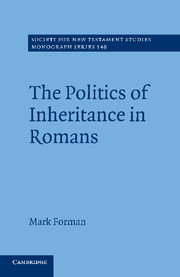Book contents
- Frontmatter
- Contents
- Preface
- List of abbreviations
- 1 Introduction: the politics of inheritance?
- 2 Some features of Greco-Roman society in the symbols, ritual and literature of Paul's time
- 3 Promising the world: inheritance in Romans 4:13–25
- 4 Suffering “conquerors”: inheritance in Romans 8:17–39
- 5 “Riches for the world”: inheritance in Romans 11:1
- 6 “Lords” over all the world: the language of inheritance in Galatians
- 7 Inheritance in 1 Corinthians and Colossians
- 8 Conclusions
- Bibliography
- Index
- References
1 - Introduction: the politics of inheritance?
Published online by Cambridge University Press: 03 May 2011
- Frontmatter
- Contents
- Preface
- List of abbreviations
- 1 Introduction: the politics of inheritance?
- 2 Some features of Greco-Roman society in the symbols, ritual and literature of Paul's time
- 3 Promising the world: inheritance in Romans 4:13–25
- 4 Suffering “conquerors”: inheritance in Romans 8:17–39
- 5 “Riches for the world”: inheritance in Romans 11:1
- 6 “Lords” over all the world: the language of inheritance in Galatians
- 7 Inheritance in 1 Corinthians and Colossians
- 8 Conclusions
- Bibliography
- Index
- References
Summary
In the immediate aftermath of World War II, Colin McCahon, one of Aotearoa New Zealand's foremost artists, produced a painting called I Paul, to you at Ngatimote. In this painting McCahon, who is increasingly ranked as one of the masters of mid-twentieth-century modern art, did what Pauline interpreters have often attempted but have consistently struggled to do – to situate the apostle Paul within a particular landscape in order to tease out the significance of his message for a specific locale. McCahon does not offer many clues to the content of the scroll which Paul holds in his hand for the people of Ngatimote, New Zealand, but several aspects of the painting are revealing and unintentionally crystallize issues which have frequently been a concern of Pauline scholars, especially over the last century. The painting explores war and its devastating consequences. Flying above the figure of Paul is what appears to be a military aeroplane and behind Paul (as well as a self-portrait of McCahon) is barbed wire. In other words, for McCahon both the context of Paul's message and the content of his letters are of this world. In the midst of a landscape of war and violence Paul is to be found on the earth, with the people, presumably because he has a message which, despite the reality of the struggles of this world, may offer hope and solidarity to the community of which he is a part.
- Type
- Chapter
- Information
- The Politics of Inheritance in Romans , pp. 1 - 19Publisher: Cambridge University PressPrint publication year: 2011

